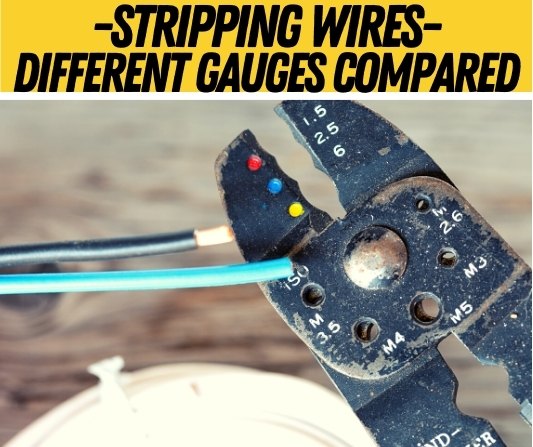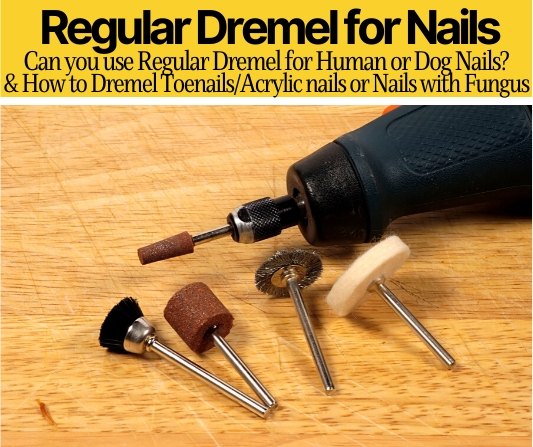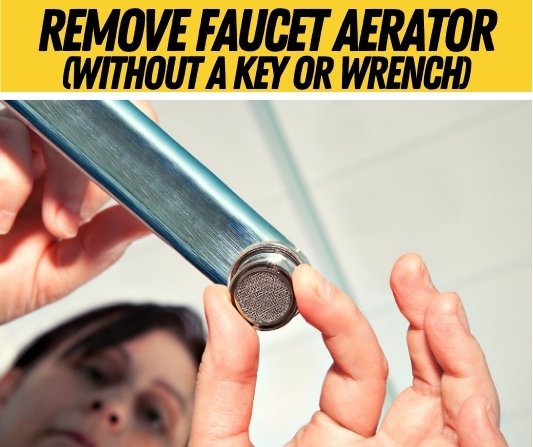 When cutting a carpet, you want to make sure you get it exactly right and have the right tool required to do it accurately without messing up the edges of the carpet.
When cutting a carpet, you want to make sure you get it exactly right and have the right tool required to do it accurately without messing up the edges of the carpet.
Not only that ,you need a tool that can do it efficiently and FAST – as carpet installation can be fairly labour-intensive work.
In this article we will See what tools you can cut carpet with and what are the best tools out there to get the job done just right!
Best Tool To Cut Carpet
If it’s just for a one time job, a utility knife and a pack of extra blades will do a great job at cutting a carpet. They allow precision and quick cutting. But if this is going to be a continuous project, or you want to make it even easier for yourself, you may want to invest in a more comprehensive tool for the job such as Electric Carpet cutter shears or Stand-Up Carpet Cutter.
Cutting carpet sounds like it can be difficult, but with the right tools, it can be very easy. In this Article we will see all the tools you can cut carpet with, how to use them and compare them against each other for different carpet installation/cutting tasks such as cutting carpet corners/edges ,cutting carpet padding or even removing the old carpet for removal.
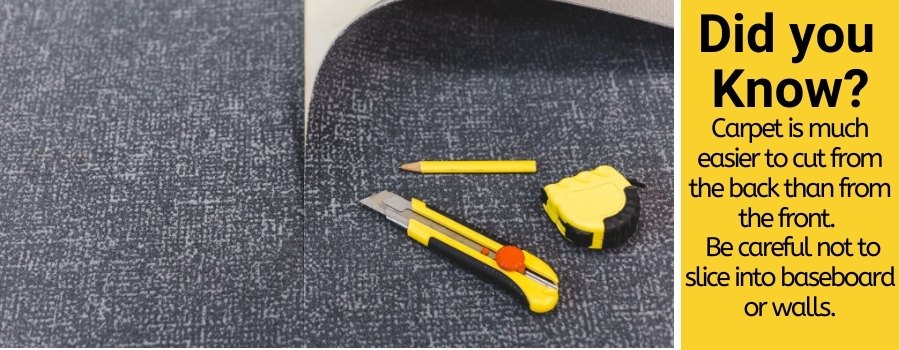
Tools You Can Cut Carpet With
There are several different types of tools you can use to cut carpets. This includes carpet knives, carpet shears, stand-up carpet cutters, carpet cutting scissors and electric carpet cutters. Each one comes with its own benefits and drawbacks, depending on the job you’re trying to fulfil, and what your budget is. Carpet cutting can be very cheap and relatively easy, and the tool chosen can often come down to personal preference.
A carpeting term you will need to know is high pile and low pile carpet. High pile carpet is the long fibred, looser carpet, whereas low pile carpet is denser and more tightly bound together. The two different types of carpet are better with different tools.
Electric Carpet Cutter
An electric carpet cutter delivers a very smooth cut that requires no force from the user. You would never have to worry about a jagged or rough cut, as the blade is so fine it glides through the material. For someone who is frequently cutting carpet, or has a large job that needs fulfilling, an electric carpet cutter could save you a lot of time and labor. Electric carpet cutter are good with both high and low pile carpet.
The first drawback is its price. Now, you can pick up an electric carpet cutter for $30, but their smoothness will not be as good as the average carpet cutter, which usually costs between $68-$500. The most expensive cutters can be anywhere between $1000-$3000. This price is only worth it if you’re going to be cutting a lot of carpets.
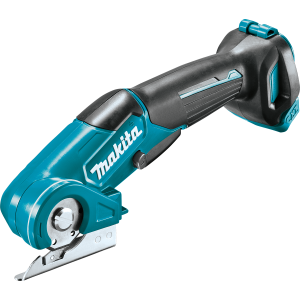
Carpet Cutting Scissors
Carpet cutting scissors are a much cheaper alternative for cutting carpets, and offers a tool that any user will be familiar with. Since most people are well adept with scissors, they may opt for carpet scissors for cutting carpet, as they are comfortable with them, which may allow a better level of precision. If you’re cutting the edges into a certain shape, in order for the carpet to fit flush against a wall, for example, then carpet cutting scissors is ideal for the job. You can expect to buy a pair for $15-25.
The obvious downside to cutting with scissors is that it’s time consuming. If you have to cut through reams of carpet, then it could take hours. Not to mention it will be laborious and straining on the hand. The thickness of the carpet and the quality of scissors will vary the quality of the cut, but you’re more likely to get a rough cut with scissors, than you would with an electric cutter. Scissors are good with both types of carpet, but can struggle with some types of high pile.
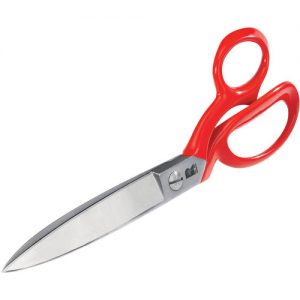
Electric Carpet Shears
Electric carpet shears are an excellent way to shape and even out carpet edges. They’re particularly effective on high pile, as it can be difficult to get a good cut on the edge, and some touch-up work may be needed by the shears. For professionals, who lay a lot of carpet, this tool is really effective in seamlessly connecting two pieces of carpet together, or to allow them to sit snugly against the wall.
As you may have guessed, electric carpet shears don’t come cheap. Ranging from $150-$500 averagely, carpet shears are expensive. Is this prices worth it? I’d have to say, in most cases, no. Electric carpet shears are a more superfluous tool compared to the other’s on this list, as they’re used to shape the carpet, rather than cut it. If you’re looking to simply cut carpet, there are cheaper alternatives. Electric shears are more for professional use.
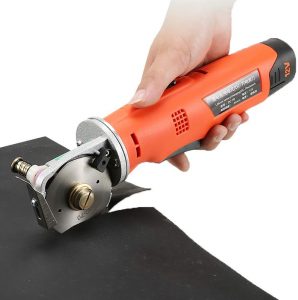
Stand-Up Carpet Cutter
Stand-up carpet cutters are a nice alternative for those who do not want to be on the floor and bending over for the duration of the carpet cutting, perhaps with mobility or back issues. It is an excellent tool for removing carpet, as it allows the user to pick it up off of the floors without having to go down, and cut through it. It is surprisingly precise for a tool that takes the user further away from the cut, but needs to be used carefully.
The price can be surprisingly high, from $100-$200, which can put people off stand-up carpet cutters. It is also important to note that they are not electric, so they perform not do the work for you, there is still labor in the movement. Stand-up carpet cutters only seem worth it for those worried about injury from conventional carpet cutting, or for those who will be doing a lot of carpet removal.
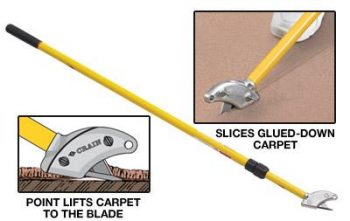
Carpet Knife
A carpet knife is the cheapest option for carpet cutting. You can expect to pick one up from $3-$10. They’re very straight forward to use, simply mark out the line for which you’d like to cut, and then pull it through the material. Those familiar with box-cutters would probably prefer this tool, as it is similar to what they have used before, and therefore may be more adaptable to it.
The degree of precision is debatable with a carpet knife, as it depends on the skill of the user. It cannot offer the same amount of precision as electric carpet shears or electric carpet cutters. The blade will also need replacing often, if you’re cutting a lot of carpet, a dull blade will not work well. The cuts can be very clean, but again, there is more of a risk of it going poorly compared to when using an electric tool.
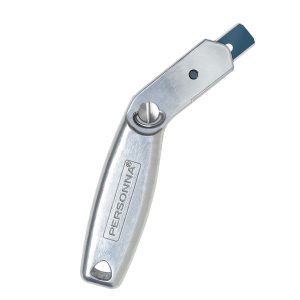
Best Way to Cut Carpet
As previously mentioned, the best way to cut carpet depends on your budget and what the specifics of the job are. All these tools could be used to cut carpets, with perhaps the exception of carpet shears, which are more for contouring. If you’re doing a one-time job for the home, then there is nothing wrong with a carpet knife and a pack of extra blades, or a pair of carpet scissors. It might be more effort, but it’ll save you a lot of money.
If you’re a professional, or have a lot of carpet that needs doing, and want to make sure it fits flush against the wall, then an electric carpet cutter will save you the most time and effort. Electric carpet cutters glide through the material, low or high pile, like butter.
What would be the Easiest Way to Cut Carpet?
The easiest way to cut carpet is undoubtedly the electric carpet cutters, as the smoothness achieved via an electric blade is unmatched. Not to mention, of course, the lack of labor that is involved. If you have a lot of carpet, you’d eventually feel strain when using a manual tool, compared to an electric carpet cutter. An electric carpet cutter is tethered by its wire, which may make it difficult to properly contour an edge that is far from a socket, in which case, you may need a pair of carpeting scissors. Otherwise, they can’t be matched in terms of ease.
Carpet knife vs Utility Knife for Cutting Carpet
A carpet knife and a utility knife is an almost interchangeable term, as the two are very similar and fulfil very similar roles. They’re both a handheld retractable blade, usually in a plastic casing. This similarity begs the question: is a carpet knife necessarily even better than a utility knife? If I have a utility knife already, do I need to buy a carpet knife?
Best Knife to Cut Carpet
Carpet knives will do a better job at cutting carpets, but not by much. Carpet knives have a slightly different shaped blade, in that its straight rather than sloped at the end, which gives it more of a blunt force that’s needed for cutting carpets. The replacing of a carpet blade can be easier than with a utility knife, as the blades need to be replaced often.
However, I wouldn’t go out and purchase a carpet knife if you have a good utility knife. I would advise, instead, to go buy more blades for your utility knife, as you’ll need a few to get through a carpeting job.
Best Blade for Cutting Carpet
The quick answer to this is a sharp one. Dull blades when cutting carpets is really tough, and can cause strain and waste time. I have used myself blades made by Irwin or Milwaukee and they are very long lasting for carpet cutting tasks compared to the cheaper no-name branded ones. A tool with a straight blade is best for both the removal and cutting of carpet, as it allows the user to create smooth, seamless cuts. Also, it’s always advisable to purchase one with a safety button, so the knife doesn’t come out when not in use.
Best tool to cut old carpet
When removing old carpet, there’s no attention to detail or precision needed, you just want to rip it all out. This is why a simple carpet knife or utility knife will do the job. They will easily tear through the carpet, high or low pile. At the end of the day, when removing old carpet, it’s going to take labor. You will need to rip it off from the adhesive that stuck it down, so there’s often no point buying a more comprehensive tool for this job, because it won’t save you from straining. Alternatively, if you’re a DIY hobbyist and have cutting tools, then many of these could be used for carpet cutting.
Best way to cut carpet for removal
Carpet cutting shouldn’t be that difficult of a job, but there’s little things you can do to make it even easier for yourself. Firstly, cut a square out at the corners, to give yourself somewhere to rip from. The adhesive usually runs the perimeter of the carpet, which means the first part is going to be the hardest, as you have to pull the carpet off a whole side, which will all be stuck down. Once you’ve done this, you want to fold it over the remaining carpet, and cut it with the utility knife. Continue ripping, folding and cutting until there’s no carpet left.
Best tool to cut carpet padding
Again, the simple utility knife is the most effective tool for the job. Carpet padding often needs to be cut to the dimensions of a room, which means you’ll need to be up against a wall. This would be difficult with an electric carpet cutter or stand-up carpet cutter, as your movement is limited by the wall. A utility knife is small and efficient to use. Furthermore, a great amount of precision isn’t really necessary, as the padding is there to protect the carpet from damage, so doesn’t need to be completely flush.
Best way to cut carpet padding
Once again I will stress the importance of a sharp blade, as this will make an effective, clean tear. Sometimes, it helps to run the blade over the desired path lightly, to mark out the cut. Then, quickly and with force, pull the knife across the carpet to get a nice clean cut. Usually, carpet padding isn’t too difficult to get through, but you may need to run over it a second time to completely separate the two pieces.
Best tool to cut carpet tiles
High pile carpet tiles can often take 2-3 attempts with a utility knife to completely cut through. If you’re cutting a lot of tiles, and do so frequently, an electric carpet cutter could be a cost-effective tool to get through carpet tiles quickly. That being said, carpet tiles are never particularly large, so getting through them with a utility knife, isn’t difficult, it’s just time consuming.
Best way to cut carpet tiles
It is important, with carpet tiles, to make sure you’re always placing them the correct way. The fibers in a carpet may not look like they’re facing a particular direction, but it can be noticeable when the job is completed, and there’s one square brushing in a different direction.
Placing the first carpet tiles is easy, as they don’t need to be cut at all. Once these are placed, you’ll then need to begin cutting tiles to shape the remainder of the floor. Using the wall, you’ll want to mark with a pen how much carpet you need to be cutting off. Then, cutting the carpet on the floor, and not on other carpet, pull the blade through the carpet. Small pieces can be cut with the blade going perpendicular to you, but larger pieces need the blade being pulled towards you. However, make sure that the blade is not being pulled completely towards yourself, but beside you. Pulling directly towards you increases the chance of injury.
Best tool to cut carpet corners
Arguably the trickiest part of carpet cutting is properly fitting a carpet into the corners. It may seem odd, but the utility knife is still your best option, despite it being the cheapest. Apart from being easy to get right into the corner of the room, as the tool is small, the utility knife also helps prevent you from cutting the carpet underneath the piece you are cutting. Due to the nature of this cut, you don’t want a tool that is too powerful, or applies too much pressure from above, as you could risk damaging the carpet beneath.
Best way to cut carpet corners
Once the carpet has been placed, and any ripples or bumps have been stamped to the edges, cut the carpet upwards from the corner, this will allow more precision when measuring the carpet. You’ll want excess carpet running slightly up the wall. Then, fold the excess carpet over the carpet on the floor, and cut it so there’s 10cm excess left. It’s better to cut not enough, than too much, in this scenario. Do this on both sides of the corner. The carpet should then be pushed into the walls, and tucked. The remainder of the excess should be cut away, to 1cm, and the ends should be tucked into the bottom of the wall using a carpet tucker.
Best tool to cut a circle in carpet
Depending on how big the circle is, you’ll want to use an electric carpet cutter, carpet scissors or carpet knife. If it’s a big circle, then an electric carpet cutter will allow a quick and smooth cutting for a circular-shaped hole within the carpet. It will also help you maintain a long cut. However, if you need to do a smaller hole, a carpet knife will do the trick, as you can easily sweep it in a circular motion, if you follow it around as you cut. However, if the hole is really small, then a pair of carpet scissors will be your best bet to create an accurate, small hole.
Best way to cut a circle in a carpet
The best preparation you can do for a circular cut is a mold, i.e. a shape to cut around, to ensure it is the correct size. With any shaped cut, precision is often key, so making an accurate mold from cardboard will greatly help your accuracy. Remember to take your measurements from the outer edge of whatever you’ll be placing the carpet against, not the inner edge. Then, simply cut around the mold. One fluid motion is often best, but if you’re using a pair of scissors you have the luxury of being able to take your time, unlike with an electric carpet cutter, which can often feel fast when in use.
Best tool to trim carpet edges
Carpet edges require a very similar cutting style to that of carpet corners, as they are both essentially fitting the carpet to the wall. Carpet edge cutting involves the folding of the carpet onto itself, and therefore it is better to use an instrument that does not run the risk of cutting into the bottom carpet too easily, but is sharp enough to cut the folded over part smoothly. That’s why I personally would you a utility knife, as it give you the sharpness you need, without comprising the rest of the carpet, as perhaps an electric carpet cutter or stand-up cutter could do.
Best way to trim carpet edges
Doing the closest corner to the desired edge first, is always advisable, to ensure the carpet is not bunched up, and will sit smoothly once fitted. You’ll want to cut the carpet so there is an excess of about 10cm, which will ride up the wall slightly. Then, you’ll want to push the carpet firmly into the wall, to make sure it will sit flat and snugly once cut. Then, bending the carpet so it creates a proper crease, you’ll want to cut it again, with about 1cm excess. When cutting it both times, you’ll need to fold it over the rest of the carpet on the bottom. Do not press down too hard or you’ll cut the rest of the carpet. Once it is cut, use a carpet tucker to get it right into the walls.
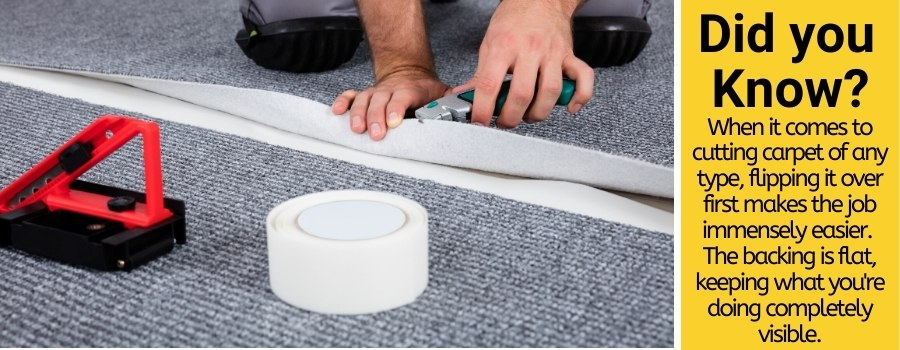
Other Tools you can Cut Carpet With
You may be a DIY tinker or hobbyist who already has a handful of tools that could possibly cut and shape carpet for a room. There’s not point buying a new tool if one you already have will do the trick. That being said, a utility knife is very cheap, and there’s no harm in purchasing one if you’re unsure if your tool will do the job as well as you want it to.
Box cutter
A box cutter can often be an interchangeable term for utility knife or carpet knife. The main determinant to look out for with a box cutter is whether it has the strength. Cheap box cutters can be quite flimsy. If you’re cutting through reams of high pile carpet, you want to make sure it can withstand the force exerted on it, to pull it through, and produce a smooth cut. It is advisable to still purchase a good utility knife instead, that can fulfil both carpet cutting, and whatever you otherwise needed the box cutter for. Don’t purely buy a box cutter for carpet cutting.
Oscillating Multitool
The oscillating multitool’s function is to perform a variety of jobs, and one of those is carpet cutting. They’re very good for removing carpet, as precision is not needed, and they can quickly, without being laborious, cut through the carpet. Multitools have different blade attachments, and you want to make sure you choose a smooth, straight blade, that will make a cut without serration or jaggedness. In general, yes, an oscillating multitool is a perfectly fine tool to use for cutting carpet, but an amount of caution is needed as it can be powerful. It is inadvisable for a beginner to use one.
Circular saw
Small, handheld circular saws are an ideal way to quickly cut through carpet for DIY and home projects. Anything larger, that requires a station, is often difficult to use for carpeting, as you want to take measurements and cut it in the moment. A large, circular saw tool would work, in practice, but is just too big for the job, and would ultimately be time consuming to use. One benefit of a circular saw is you can push it away from you, rather than drag it towards you, which makes it safer.
Regular scissors
Regular scissors will not cut through carpet effectively. They are simply not sharp enough, and would dull quickly. There’s a reason that carpeting scissors exist, that are sharper and are designed to cut through the thick fibres of carpets. You’d end up ruining the scissors, and making them ineffectual for their normal purpose. If you’re turning to scissors to cut carpet, I advise buying a cheap utility knife to do the job much better, and save you creating a jagged, unusable edge on your carpet. There is a chance it could work on low pile carpet, if it’s particularly thin, but the risk of creating a rough edge isn’t worth it.
Dremel
A Dremel multi-knife is similar to that of an oscillating multitool, in that it is designed to cut through soft materials, like carpet, and have application within the home. It works well with removing carpet, as it can quickly go through large reams of the material, and quicken the job compared to if it was to be done with a utility knife. The only downside is you’ll need to replace the blade after a while, or sharpen it, as carpet cutting will dull it significantly. There’s no reason not to use a Dremel, unless trying to make a really precise cut, that would require a smaller implement.
Sawzall
Whether to advise the use of a Sawzall is a tricky one. A professional could probably use it fine, and I see no problem with using it to remove old carpet, or for making long cuts on a large piece of the material. However, due to the nature of the tool and how the blade would cut the carpet, it’s not advisable to use it when fitting new carpets. When fitting new carpet, you have to fold the carpet over itself and cut it, without cutting the carpet beneath. Sawzall’s have a high risk of cutting the carpet underneath, compared to other tools. While it has the power to do it, cut at your own risk, as you could damage other materials in the process.
Jigsaw
The use of a jigsaw is a similar story to that of a Sawzall. It would work, and would smoothly cut through the carpet and create a nice edge without jaggedness, but they require a higher level of skill, and you could cut through a material beneath it in the process. I would only advise the use of a jigsaw to someone who is certain that they will not cut through any material beneath the carpet. Jigsaws are used more in workshops, and in construction environments, with carpeting you must remember you’re on the floor cutting very close to walls, the floor and other pieces of carpets. You don’t want a tool too superfluous for the job.

